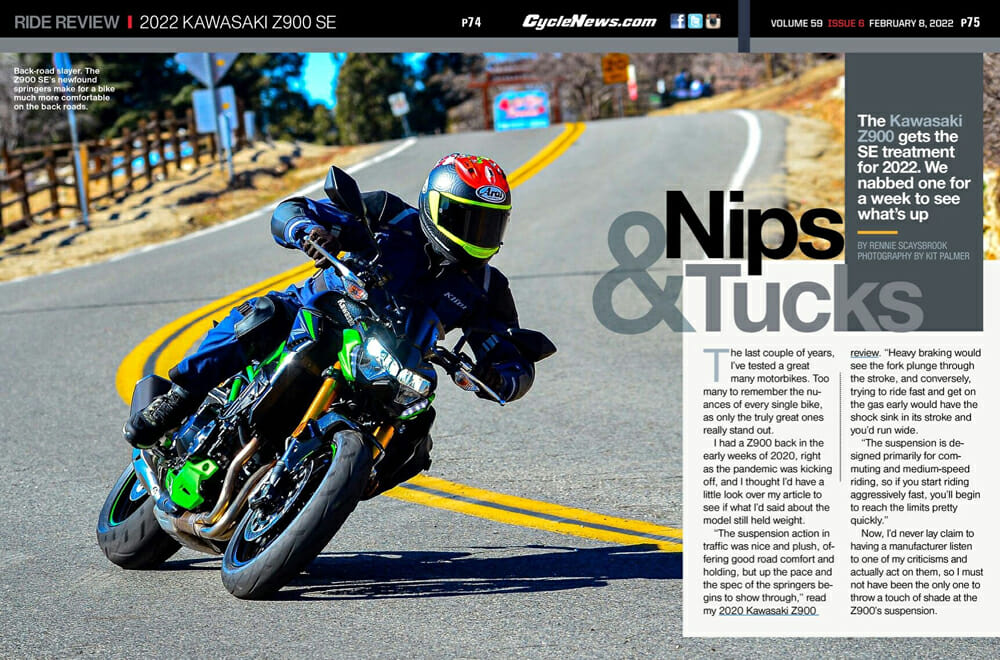Rennie Scaysbrook | February 12, 2022
The Kawasaki Z900 gets the SE treatment for 2022. We nabbed one for a week to see what’s up.
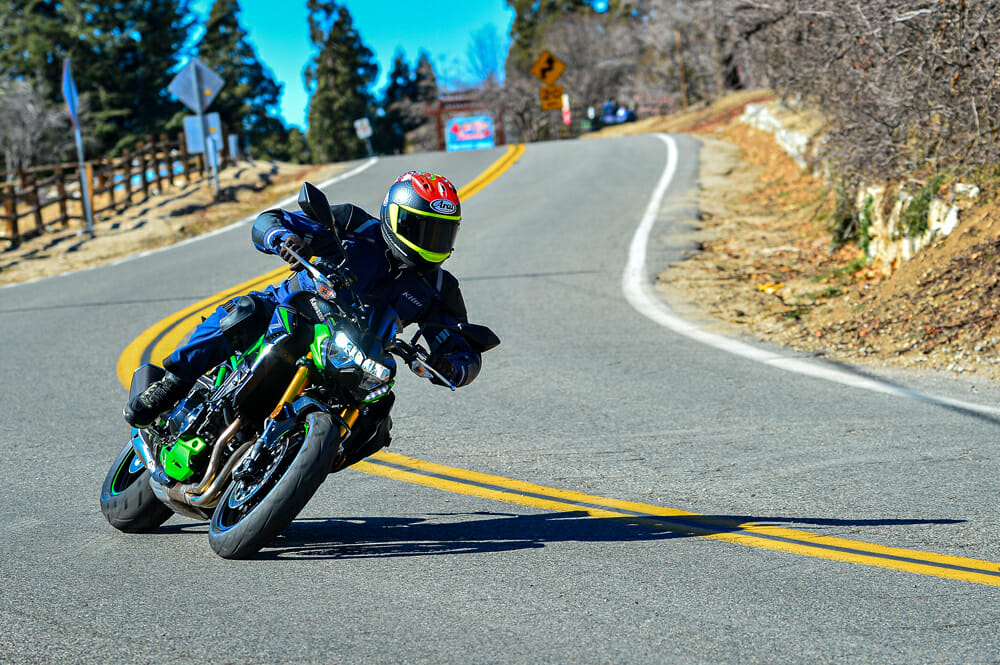 Back-road slayer. The Z900 SE’s newfound springers make for a bike much more comfortable on the backroads.
Back-road slayer. The Z900 SE’s newfound springers make for a bike much more comfortable on the backroads.
By Rennie Scaysbrook | Photography by Kit Palmer
The last couple of years, I’ve tested a great many motorbikes. Too many to remember the nuances of every single bike, as only the truly great ones really stand out.
I had a Z900 back in the early weeks of 2020, right as the pandemic was kicking off, and I thought I’d have a little look over my article to see if what I’d said about the model still held weight.
VIDEO | 2022 Kawasaki Z900 SE First Ride
“The suspension action in traffic was nice and plush, offering good road comfort and holding, but up the pace and the spec of the springers begins to show through,” read my 2020 Kawasaki Z900 review. “Heavy braking would see the fork plunge through the stroke, and conversely, trying to ride fast and get on the gas early would have the shock sink in its stroke and you’d run wide.
“The suspension is designed primarily for commuting and medium-speed riding, so if you start riding aggressively fast, you’ll begin to reach the limits pretty quickly.”
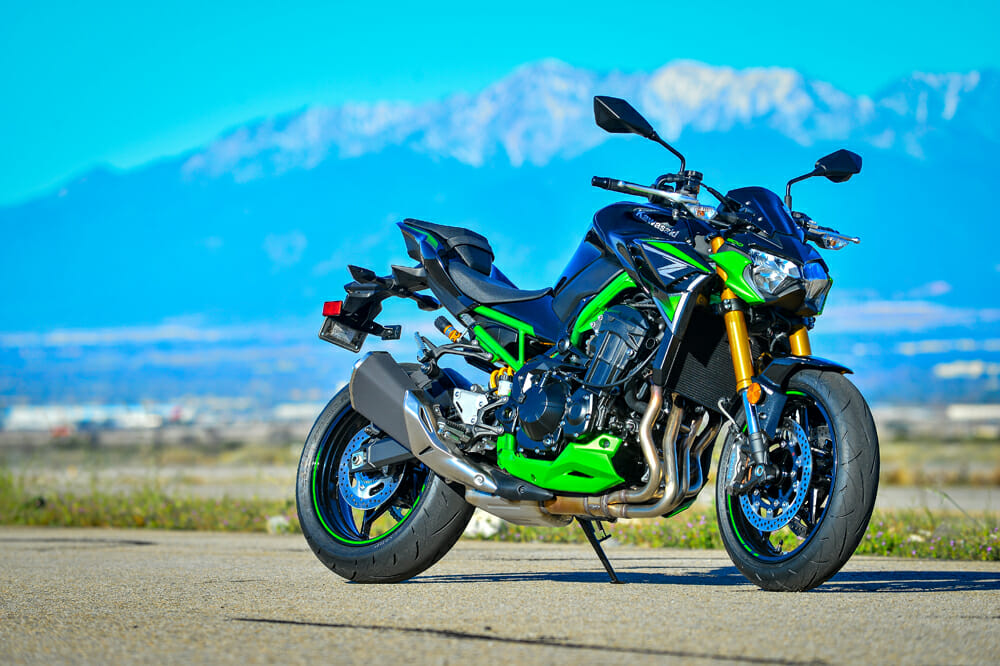 The styling is a bit hit-and-miss for some, but we’ve grown to like the Zee. Those gold forks certainly look the part.
The styling is a bit hit-and-miss for some, but we’ve grown to like the Zee. Those gold forks certainly look the part.
Now, I’d never lay claim to having a manufacturer listen to one of my criticisms and actually act on them, so I must not have been the only one to throw a touch of shade at the Z900’s suspension.
That’s because, for 2022, we’ve now got the Z900 SE (which I can only assume means Special Edition), one complete with a revised Showa fork and a fancy Ohlins S46 shock.
On top of that, the brakes (another area I slated), have come in for a rework. Instead of running the old-school Nisin conventionally mounted calipers and wooden-feeling master cylinder, the new SE comes with Brembo 4.32 monobloc calipers, steel lines and, a new Nissin master cylinder. Huzzah!
The SE is thus the second Z900 you can buy. The base model’s price—like absolutely bloody everything in life since Covid—has gone up by $200 to $9199, the SE will set you back an extra $1500 to get the improved suspension and braking package because aside from those features (and the fancy KRT paint job), the bikes are exactly the same.
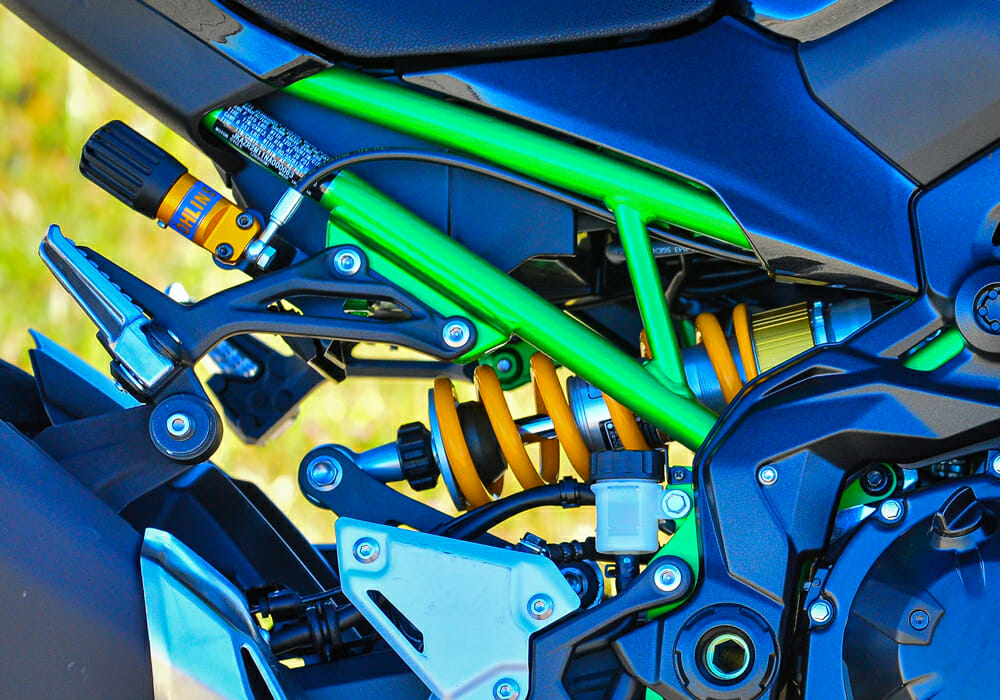 New Öhlins shock brings much needed stability to the platform but it is not fully adjustable, which is a shame.
New Öhlins shock brings much needed stability to the platform but it is not fully adjustable, which is a shame.
That means you will still get the 948cc inline four-cylinder motor, producing a relatively modest 125 horsepower and 73 lb-ft of torque, the same tubular steel chassis and subframe and identical Sugomi styling from Kawasaki’s patented, err, Sugomi department.
Aside from the suspension and brakes, the Z900 hasn’t changed an awful lot over the years. It replaced the aging Z1000 back in 2017, and although it was Kawasaki’s main naked bike until the bonkers Z H2 came along in 2020, it was never meant to challenge the naked bike bangers like the KTM Super Duke or Aprilia Tuono 1100 V4.
You could angle the Z900, and thus this SE model, as a middleweight, going up against the new-for-2021 Yamaha MT-09/MT-09 SP and the KTM 890 Duke/890 Duke R. And in that regard, the Kawasaki stacks up pretty well.
But we’re not doing a comparison test here. This is purely about how the new springers ride and how the stoppers stop, and whether the extra cash paid is worth the cash paid.
 Nissin has fitted a new master cylinder and together with the Brembo calipers; braking is much improved.
Nissin has fitted a new master cylinder and together with the Brembo calipers; braking is much improved.
The new suspension is certainly stiffer when you first sit on it. It’s more noticeable at the rear, which has a much more taught feeling even at a standstill. Get the Z900 SE moving, however, and the difference in dollars starts to shine through.
The bike I rode in 2020 would start wallowing and protesting at the mere thought of turning up the wick from moderate medium speeds, let alone actually going really hard. This is not the case with the SE, with the rear shock keeping the ride much more composed, especially when you begin winding on the power on the side of the tire.
There’s no difference in tire here. Both the SE and base model run the Dunlop Sportmax Roadsport 2 rubber, which is Dunlop’s middle-of-the-road sporty street tire, so the extra drive grip and chassis composure is purely down to the Ohlins shock sitting under my butt.
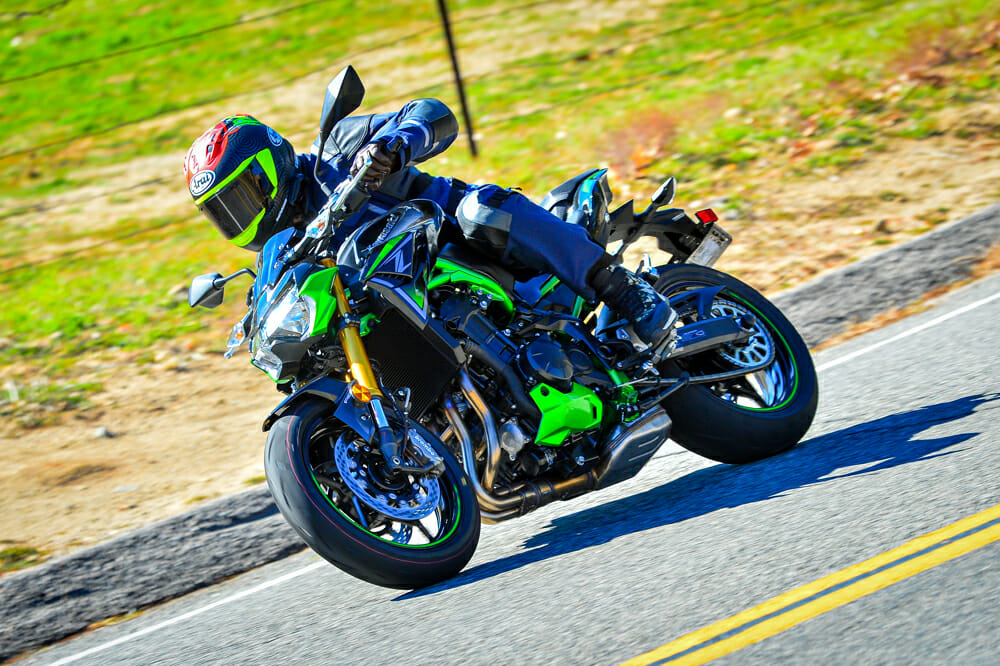 It’s still a relatively short machine, as evidenced by Rennie’s 6’1” frame here.
It’s still a relatively short machine, as evidenced by Rennie’s 6’1” frame here.
The front end, while being a bit on the stiff side, is an improvement over the base model I rode in 2020, but it’s not as big a difference as to how the shock feels. There’s better resistance to hard braking in that, on standard settings, the fork won’t race to the bottom of the stroke quite as fast as it did before, but overall, the feeling from the handlebar is quite similar.
Changing thoughts to the brakes, there’s much more bite from the Brembo calipers and more feel at the lever. The difference is noticed more at slow-to-medium speeds, where heavy braking isn’t really required. Here’s the new master cylinder provides a smoother initial bite but, a bit like the forks, it isn’t night and day different but just a little better everywhere.
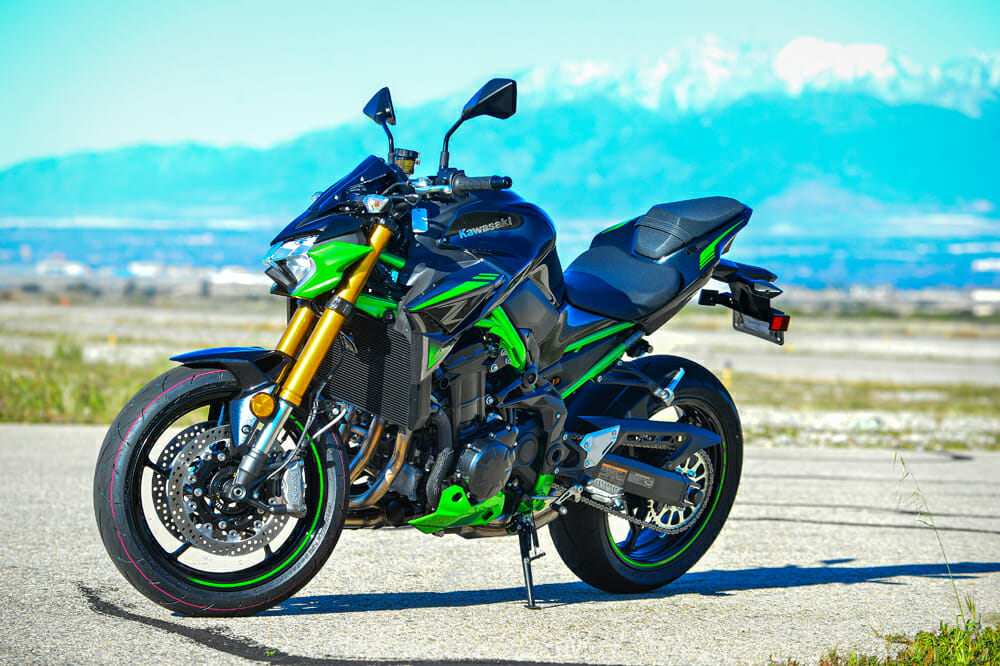 Little nips and tucks, nothing revolutionary, for the ’22 Z900 SE.
Little nips and tucks, nothing revolutionary, for the ’22 Z900 SE.
As for the remainder of the machine, it is as you were in 2020. I haven’t shrunk (as far as I know), so I still find the overall ride position a little on the cramped side. With a seat height of 31.5 inches, it should put the Z900 SE right in the sweet spot if you’re about 5’10” or lower, but for me, being three inches taller and all, I could use a bit more room.
There are very little creature comforts with the SE, some of which I’d really have loved to see fitted. Such as cruise control. The SE is plenty capable of having it, even if it must be included as an optional extra from the accessories catalog, but alas, not so.
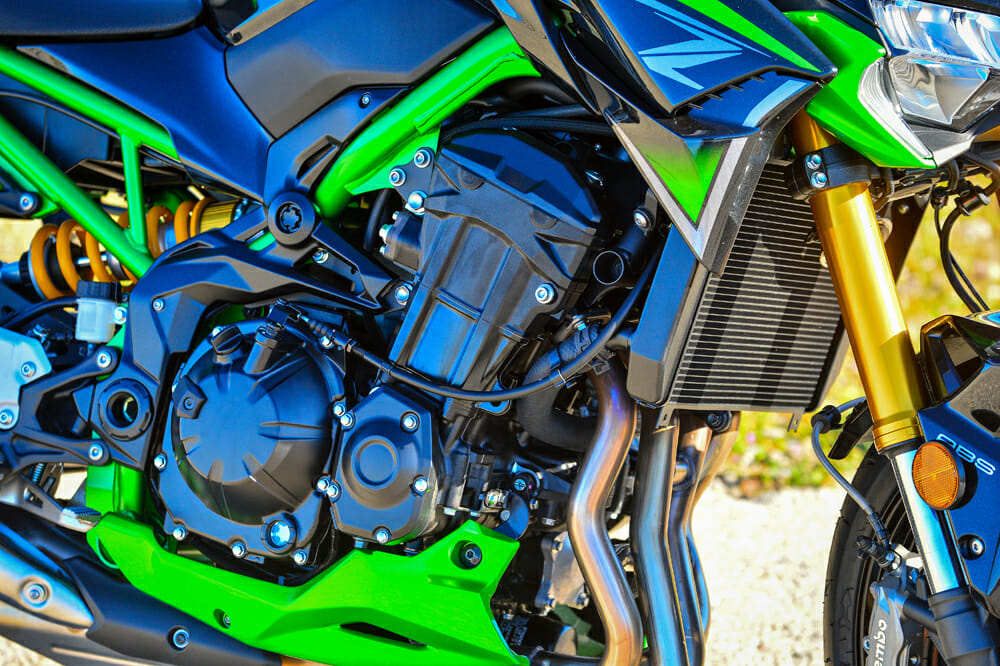 The engine hasn’t changed from the base model to this SE edition, with Kawasaki claiming 73 lb-ft of torque from its 942cc.
The engine hasn’t changed from the base model to this SE edition, with Kawasaki claiming 73 lb-ft of torque from its 942cc.
You don’t get IMU-monitored electronics, and no quickshifter, but you do get traction control, four riding modes of Rain, Street, Sport and Rider (which allows you to switch the TC off), and two different power modes on Full and Low. This is all to keep the costs down but considering the SE has already passed the magic $10K mark thanks to the suspension and brakes, I’d have liked TC to be at least an option.
For the money, the Z900 SE is indeed a good buy but considering it’s only $500 cheaper than the Yamaha MT-09 SP that does come with an IMU and cruise control and Ohlins, Kawasaki’s starting to push it, if only a little.
I’d certainly take the SE over the standard model because given the increase in road holding quality with the brakes and suspension, that makes the new Zee worth the money alone.CN
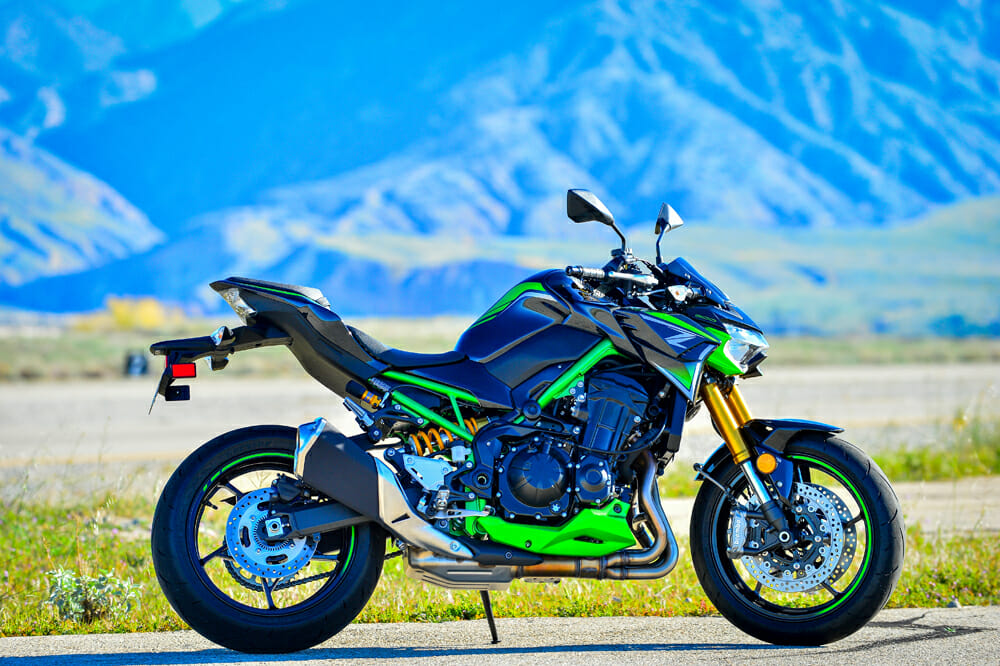
2022 Kawasaki Z900 SE Specifications
| MSRP: |
$9,699 |
| Engine: |
4-cylinder, inline 4-stroke |
| Valvetrain: |
DOHC, 16-valve |
| Cooling System: |
Liquid |
| Fueling: |
EFI |
| Displacement: |
948cc |
| Bore x stroke: |
73.4 x 56mm |
| Torque (claimed): |
73.1 lb-ft at 7700 rpm |
| Transmission: |
6-speed |
| Clutch: |
Wet multi-disc |
| Chassis: |
Tubular steel trellis |
| Front suspension: |
41mm inverted fork, fully adjustable |
| Rear suspension: |
Ohlins S46 monoshock, rebound and preload adjustable |
| Front-wheel travel: |
4.7 in. |
| Rear-wheel travel: |
5.5 in. |
| Front brake: |
Dual 300mm petal-style discs with Brembo M4.32 four-piston calipers, ABS |
| Rear brake: |
Single 250mm petal-style disc with single-piston caliper, ABS |
| Front tire: |
Dunlop Sportmax Roadsport 2 120/70 ZR17 in. |
| Rear tire: |
Dunlop Sportmax Roadsport 2180/55 ZR17 in. |
| Seat height: |
31.5 in. |
| Wheelbase: |
57.3 in. |
| Fuel capacity: |
4.5 gal. |
| Weight (curb, claimed): |
469 lbs. |
